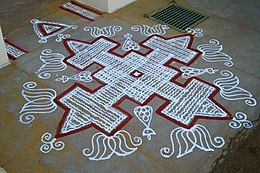
Back কোলাম Bengali/Bangla Kolam German Kolam French קולאם HE कोलम Hindi കോലം Malayalam Kolam Polish Kolam Portuguese கோலம் Tamil Колам Ukrainian


Kolam (Tamil: கோலம், Malayalam: കോലം, Kannada: ರಂಗೋಲೆ), also known as Muggu (Telugu: ముగ్గు), Tarai Alangaram (Tamil: தரை அலங்காரம்) and Rangoli (Kannada: ರಂಗೋಲೆ) is a form of traditional decorative art that is drawn by using rice flour as per age-old conventions. It is also drawn using white stone powder, chalk or chalk powder, often along with natural or synthetic color powders. Its origin belongs to the ancient Tamil Nadu known as Tamilakam and has since spread to the other southern Indian states of Karnataka, Telangana, Andhra Pradesh, and Kerala. It can be found in some parts of Goa and Maharashtra. Since the Tamil diaspora is worldwide, the practice of kolam is found around the world, including in Sri Lanka, Singapore, Malaysia, Indonesia, Thailand and a few other Asian countries. A kolam or muggu is a geometrical line drawing composed of straight lines, curves and loops, drawn around a grid pattern of dots. It is widely practised by female family members in front of their house entrance, although men and boys also practice this tradition.[1] The similar regional versions of kolam with their own distinctive forms are known by different names in India: raangolee in Maharashtra, aripan in Mithila, alpona in West Bengal and hase and rangole in Kannada in Karnataka.[2] More complex kolams are drawn and colors are often added during festival days, holiday occasions and special events.
- ^ Dr.Gift Siromoney. "KOLAM". Chennai Mathematical Institute. Retrieved 12 January 2012.
- ^ "Kolams". Auroville. Archived from the original on 30 December 2011. Retrieved 12 January 2012.
© MMXXIII Rich X Search. We shall prevail. All rights reserved. Rich X Search